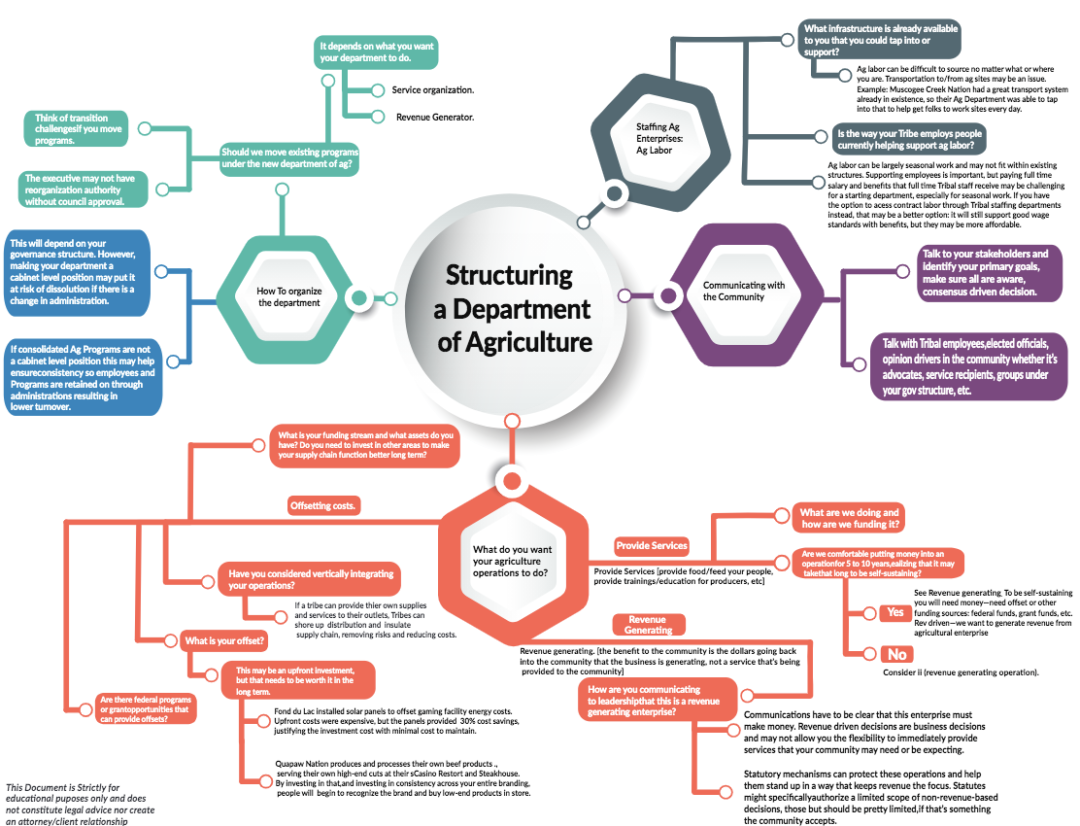How to organize the department
- This will depend on your governance structure. However, making your department a cabinet level position may put it at risk of dissolution if there is a change in administration.
-
If consolidated Ag Programs are not a cabinet level position this may help ensure consistency so employees and Programs are retained on through administrations resulting in lower turnover.
-
Should we move existing programs under the new department of ag?
-
It depends on what you want your department to do.
-
Service organization.
-
Revenue Generator.
-
-
Think of transition challenges if you move programs.
-
The executive may not have reorganization authority without council approval.
-
Staffing Ag Enterprises: Ag Labor
- What infrastructure is already available to you that you could tap into or support?
-
Ag labor can be difficult to source no matter what or where you are. Transportation to/from ag sites may be an issue. Example: Muscogee Creek Nation had a great transport system already in existence, so their Ag Department was able to tap into that to help get folks to work sites every day.
-
-
Is the way your Tribe employs people currently helping support ag labor?
-
Ag labor can be largely seasonal work and may not fit within existing structures. Supporting employees is important, but paying full time salary and benefits that full time Tribal staff receive may be challenging for a starting department, especially for seasonal work. If you have the option to access contract labor through Tribal staffing departments instead, that may be a better option: it will still support good wage standards with benefits, but they may be more affordable.
-
Communicating with the Community
- Talk to your stakeholders and identify your primary goals, make sure all are aware, consensus driven decision.
-
Talk with Tribal employees, elected officials, opinion drivers in the community whether it’s advocates, service recipients, groups under your gov structure, etc.
What do you want your agriculture operations to do?
- Provide Services (provide food/feed your people, provide trainings/education for producers, etc)
-
What are we doing and how are we funding it?
-
Are we comfortable putting money into an operation for 5 to 10 years, realizing that it may take that long to be self-sustaining?
- YES, See Revenue generating. To be self-sustaining you will need money—need offset or other funding sources: federal funds, grant funds, etc. Rev driven—we want to generate revenue from agricultural enterprise.
- NO, Consider ii (revenue generating operation).
-
-
Revenue Generating (the benefit to the community is the dollars going back into the community that the business is generating, not a service that’s being provided to the community)
-
How are you communicating to leadership that this is a revenue generating enterprise?
-
Communications have to be clear that this enterprise must make money. Revenue driven decisions are business decisions and may not allow you the flexibility to immediately provide services that your community may need or be expecting.
-
Statutory mechanisms can protect these operations and help them stand up in a way that keeps revenue the focus. Statutes might specifically authorize a limited scope of non-revenue-based decisions, those but should be pretty limited, if that’s something the community accepts.
-
-
-
Offsetting costs
-
What is your funding stream and what assets do you have? Do you need to invest in other areas to make your supply chain function better long term?
-
Have you considered vertically integrating your operations?
-
If a tribe can provide their own supplies and services to their outlets, Tribes can shore up distribution and insulate supply chain, removing risks and reducing costs
-
-
What is your offset?
-
This may be an upfront investment, but that needs to be worth it in the long term.
-
Fond du Lac installed solar panels to offset gaming facility energy costs. Upfront costs were expensive, but the panels provided 30% cost savings, justifying the investment cost with minimal cost to maintain.
-
Quapaw Nation produces and processes their own beef products, serving their own high-end cuts at their Casino Resort and Steakhouse. By investing in that, and investing in consistency across your entire branding, people will begin to recognize the brand and buy low-end products in store.
-
-
Are there federal programs or grant opportunities that can provide offsets?
-
-

